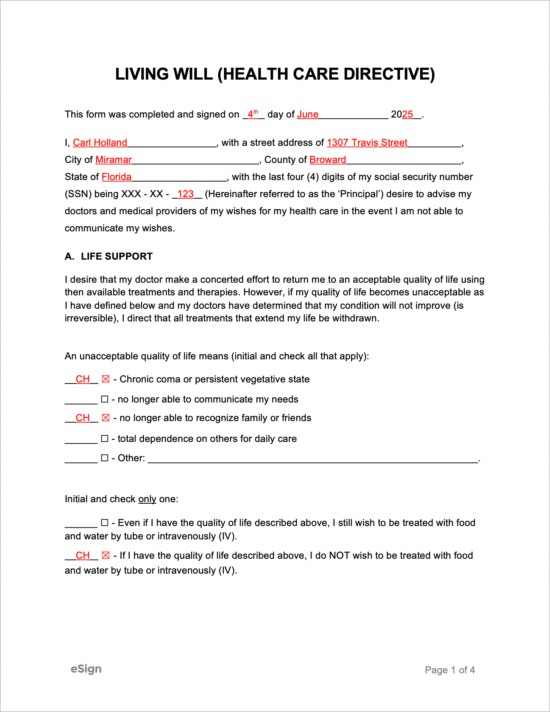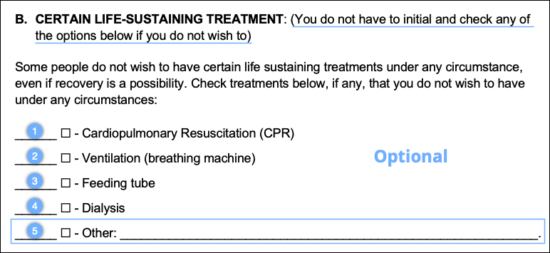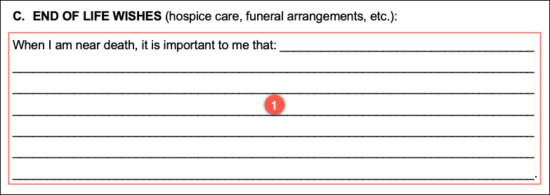Also known as a:
- Health Care Directive
- Personal Directive
- Advance Decision
By State
- Alabama
- Alaska
- Arizona
- Arkansas
- California
- Colorado
- Connecticut
- Delaware
- Florida
- Georgia
- Hawaii
- Idaho
- Illinois
- Indiana
- Iowa
- Kansas
- Kentucky
- Louisiana
- Maine
- Maryland
- Massachusetts
- Michigan
- Minnesota
- Mississippi
- Missouri
- Montana
- Nebraska
- Nevada
- New Hampshire
- New Jersey
- New Mexico
- New York
- North Carolina
- North Dakota
- Ohio
- Oklahoma
- Oregon
- Pennsylvania
- Rhode Island
- South Carolina
- South Dakota
- Tennessee
- Texas
- Utah
- Vermont
- Virginia
- Washington
- West Virginia
- Wisconsin
- Wyoming
Contents |
What is a Living Will?
A living will is a document that is completed by an adult (18 years or older) to specify how they would like to be taken care of after experiencing a serious medical event that leaves them in a state where they can’t convey their wishes (“incapacitated”). The document is frequently combined with a medical power of attorney, which is a form used for designating a trusted person to communicate with doctors on their behalf.
Benefits
- Gives one control over their treatment.
- Helps ease the burden on family members.
Living Will vs. Living Trust
A living will is solely for specifying medical care instructions and does not cover the person’s estate and other topics.
A living trust on the other hand is an estate planning document used for creating a fund that own’s a person’s belongings while they are still alive. The trustee (person completing the form) can place anything they own into the trust, including (but not limited to) motor vehicles, bank accounts, gold and jewelry, intellectual property, and real property. Once the trustee dies, the trust contains instructions on how the items are to be distributed.
Living Will vs. Last Will and Testament (“Will”)
While they both contain the word “will,” they are very different documents. A living will, as the word “living” refers to, is used for conveying the wishes of the patient while they are still alive.
In contrast, a last will and testament or simply a “will” is a form that serves as instructions for family members on how they should distribute the principal’s estate after they have died.
How to Make a Living Will
Step 1 – Get Prepared
Before one can begin stating their wishes, they need to identify how they’d like to go about completing the living will. The principal (person completing the form) can go about obtaining a living will in one of the following three (3) ways:
- Have an attorney draft the form. This is the most expensive option (can cost upwards of $250). For those with highly unique wishes, this route may make sense. However, for the majority of people, going with an attorney is overkill.
- Download and complete the free version. Select the applicable state above to download a living will that complies with the specific statutes in the principal’s state of residence. While this option is free, it’s important to do some research to ensure the form meets one’s exact needs.
- Use a form filler (most recommended). By using eSign, one gets the best of both worlds by using an attorney-drafted form that offers the user a step-by-step process, while remaining more affordable than hiring legal counsel. One can download the completed form one time for $45, or use a free 7-day trial (charges $39 after one week).
Step 2 – Determine your Wishes
The principal will need to think about and make decisions pertaining to the following items:
- What would qualify as an unacceptable quality of life (not recognizing family and friends, depending on others for daily life, being in a coma, etc.).
- Whether or not they would like to be treated via artificial life support if they are in circumstances they deem as unacceptable.
- What types of life-sustaining treatment they would not like to receive.
- Their end of life wishes (if they’d like hospice, wishes for seeing family, if they’d like a funeral, etc.).
Step 3 – Store and Share your Living Will
Once the living will has been completed and signed in accordance with state law, the principal should:
- Store a copy of the form in a safe place (a lockbox and/or a digital vault);
- Provide a copy to their physician, health care agent (if applicable), and family; and
- Inform those they care about that a living will was completed so they know to locate it in the event of a medical emergency.
Sample
Download: PDF, Word (.docx), OpenDocument
How to Write
- Step 1 – Principal’s Information
- Step 2 – Quality of Life
- Step 3 – Artificial Life Support
- Step 4 – Treatments
- Step 5 – End-of-Life Wishes
- Step 6 – Signatures
Color code:
- Red = Required
- Blue = Optional
Step 1 – Principal’s Information
The principal will need to write their personal information. This is used for identifying the principal and proving the validity of the document. All of the following must be entered:
- The full date on which the principal is completing and signing the form. Must include the day, month, and year;
- The principal’s first and last name;
- Their street address (including unit number, if applicable);
- Their city;
- County;
- State; and
- The last four (4) digits of the principal’s social security number (SSN).
Step 2 – Quality of Life
The principal can choose to initial AND check any of the five (5) options listed. By checking and initialing an option, the principal is stating that they would not want to be kept alive artificially in that particular physical/mental state.
Step 3 – Artificial Life Support
The principal must initial and check one of the two (2) options. The first option means the principal would like to be kept alive by receiving food and water through an IV (tube/needle) even if they are experiencing a quality of life they would not want.
The second option means the principal would not like to receive food or water intravenously if they have a quality of life they wouldn’t want, as selected in Step 2.
Step 4 – Treatments
This section gives the principal a means of stating any types of treatment they DO NOT WANT under ANY CIRCUMSTANCES. For example, if the principal was at a doctor’s office for a general check-up/physical, and the principal experienced a heart attack, medical professionals would NOT provide CPR to the principal if the option was initialed and checked on their living will. The principal does not have to initial or check any of the options if they don’t want to.
Step 5 – End-of-Life Wishes
The principal should use the lines provided to inform medical professionals and their family how they’d like to experience the end of their life. This section should be as descriptive as the principal can make it. If they leave anything up to assumption, medical professionals will turn to their family for guidance (which could be stressful for family members). This section should also be used for covering funeral arrangements, such as whether the principal would like to be buried, cremated, etc.
Step 6 – Signatures
Prior to signing their name, the principal should check their state’s advance directive signing laws to see how the form must be signed. If witness signatures are required, the principal needs to find one (1) or two (2) adults to observe the signing of the document. Once signed, each witness would then need to sign the document, print their name, and write their full address and phone number. If notarization is required, the principal can visit a notary in person at a local bank, postal store, library, etc., or can complete notarization online using eSign.











